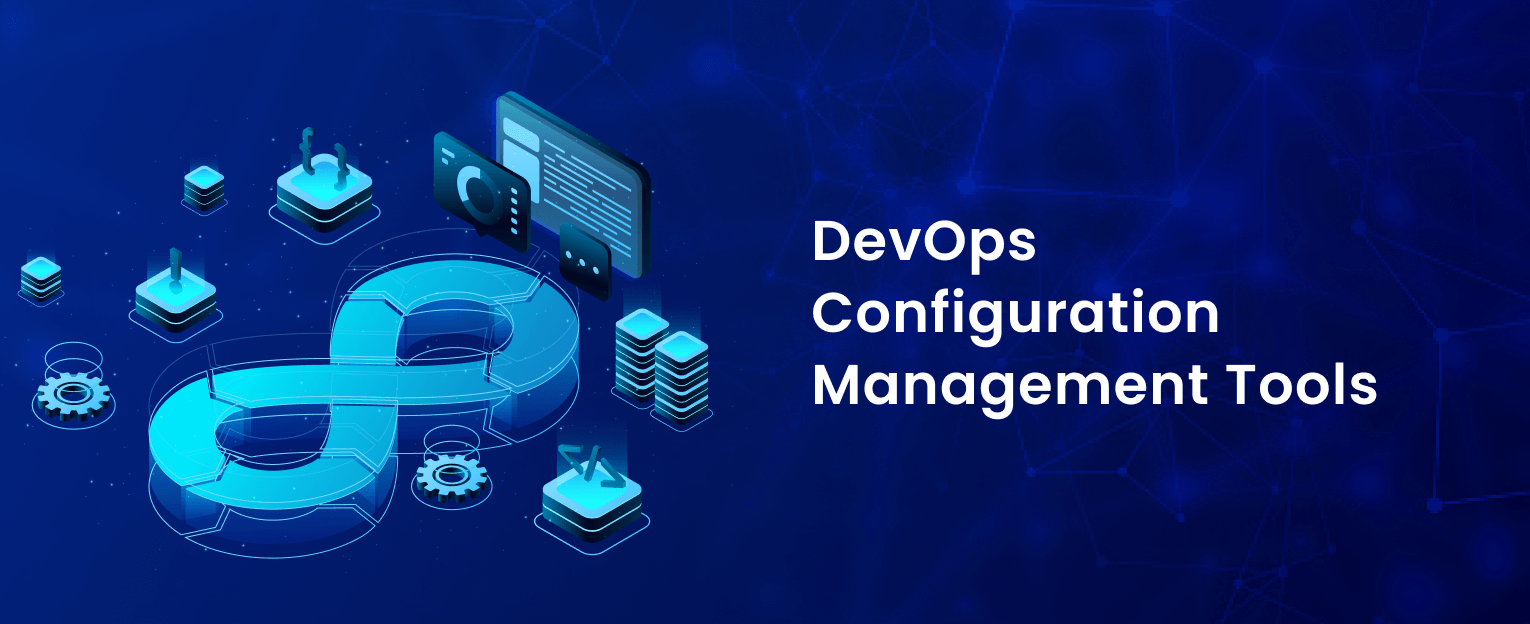DevOps has become an integral cornerstone of the IT industry, orchestrating critical functions such as app deployment, infrastructure upkeep, and the enhancement of work environments. These multifaceted tasks are the lifeblood of seamless business operations, and their optimization is further facilitated through the adept utilization of cloud configuration management tools.
According to StrongDM, the DevOps sector is on a trajectory to reach an astonishing USD 12,200 million by 2026. Furthermore, Medium reports that a remarkable 65% of companies have reported tangible improvements in their customer experience following the strategic integration of DevOps tools into their operational framework.
Forecasts by Krusche & Company indicate that the DevOps market is poised for significant expansion, with a compound annual growth rate (CAGR) exceeding 20% from 2021 to 2028.
Let’s learn about these tools in detail and see what leading experts have to say about their performance, usability, and features.
For a comprehensive grasp of DevOps optimization, this article unveils the top-tier DevOps configuration management tools.

Transform Your Business with Our Expert DevOps Services
Transform your business with our expert DevOps consulting. Schedule a consultation and accelerate your delivery today.
Why Is Configuration Management Important?
While the demand for the best configuration management tools in DevOps is constantly rising, it’s important to understand that configuration management plays a significant role in tracking and controlling IT services.
Configuration management in DevOps is essential for IT structuring, but many businesses don’t understand DevOps importance. It helps speed up the software development and operations process to complete the delivery.
It wouldn’t be wrong to say that these tools help understand how the change in one configuration item will impact the others. All in all, it plays an essential role in compliance and governance.
Types of DevOps Configuration Management Tools
DevOps Configuration Management (DCM) tools can be broken down into different types. We have listed 5 types of Configuration Management tool in DevOps that will help you easily understand which tools will be best for you:
- Infrastructure as Code (IaC) Tools: IaC tools like Terraform and AWS CloudFormation allow for the definition and management of infrastructure configurations as code. They play a crucial role in automating infrastructure provisioning and configuration.
- Automation and Orchestration Tools: Automation tools such as Ansible and SaltStack are instrumental in automating configuration management tasks, software deployment, and overall infrastructure management. They help streamline DevOps workflows.
- Configuration Management Tools: Tools like Chef and Puppet specialize in managing server configurations and ensuring consistency across environments. They are fundamental for maintaining the desired state of infrastructure and thus part of the DevOps configuration management toolkit..
- Containerization and Container Orchestration Tools: While not strictly configuration management tools, containerization tools like Docker Compose and Kubernetes are essential in DevOps for packaging and deploying applications consistently.
- Workflow Automation Tools: Workflow automation tools such as Jenkins and GitLab CI/CD play a pivotal role in automating the end-to-end DevOps pipeline, including DevOps configuration management, testing, and deployment processes.
- Policy and Compliance Management Tools: These tools focus on ensuring that infrastructure configurations and deployments comply with security and compliance policies. They help with auditing and reporting on configuration changes. Examples include InSpec and Chef Compliance.
- Cloud Management and Orchestration Tools: These tools are specialized for managing and orchestrating resources and services in cloud environments, making it easier to work with cloud providers like AWS, Azure, and Google Cloud. Examples include AWS CloudFormation and Google Cloud Deployment Manager.
These DevOps configuration tools are closely relevant to configuration management, helping teams efficiently manage and automate infrastructure and application configurations in a DevOps environment.
The Top 15 DevOps Configuration Management Tools
Using improper open source configuration management tools can create a security challenge. So, to help you out, we are sharing the 15 best tools with you below.
1. Ansible

If you are looking for open source configuration management tools, this is a good choice. It uses YAML, a declarative language, to define the playbooks and tasks. It has an agentless architecture, so there is no need for a client-side agent to be installed on the target systems.
Features:
- Ansible uses SSH or WinRM to communicate with remote systems.
- This tool makes it easy to manage a large number of systems from a central location.
- It’s extremely flexible, as you can write and retain the automation scripts.
2. Chef Infra
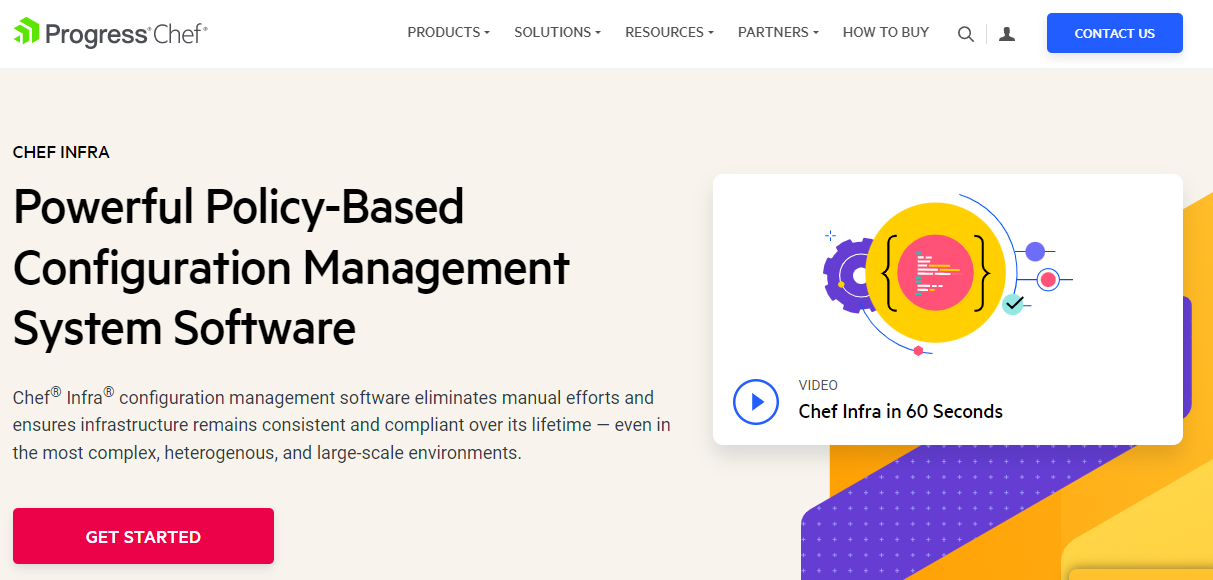
This management tool is perfect for automating software installation and configuration. It is rated as one of the best software in the DevOps consulting services industry, as it works by defining the desired state of your infrastructure in a code file called a recipe, which specifies what actions should be taken to configure each component of the system.
Features:
- Chef Infra can be used to manage infrastructure across a wide range of operating systems, including DevOps and cloud computing platforms.
- It supports a variety of configuration management tasks, such as package installation, file management, user management, and service management.
3. Microsoft Endpoint Manager
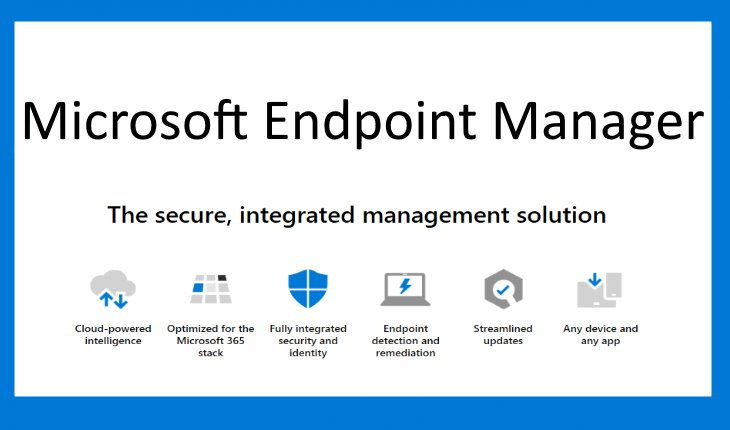
This configuration management tool, commonly known as MEM, allows companies to manage and secure the apps, data, and devices. It has combined Configuration Manager and Microsoft Intune features to manage complex and modern IT environments. It provides modern management for Windows 10 devices.
Features:
- This includes over-the-air (OTA) provisioning support, policy management, software deployment, and remote troubleshooting.
- MEM also supports Windows Autopilot, which allows organizations to provision and configure new Windows 10 devices with minimal user intervention.
- It has security features like threat protection and conditional access to prevent data loss.
4. CFEngine
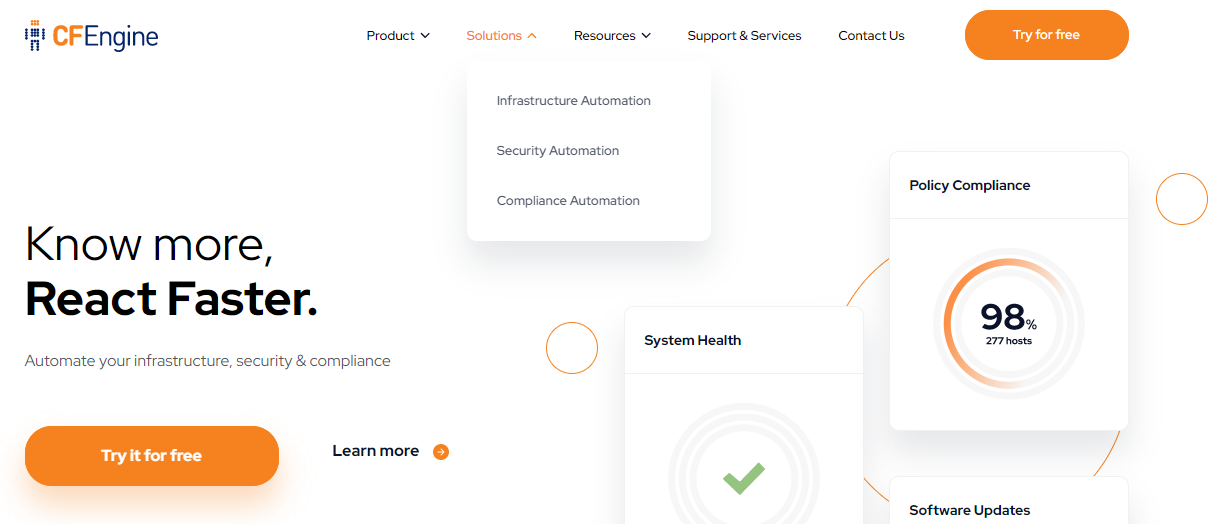
This is one of the most reliable DevOps tools, as it offers a framework for outlining and implementing security, systems management, and compliance policies.
Features:
- It works with declarative language that defines the IT infrastructure. Some of its features include vulnerability, scalability, scanning, auditing, and hardening.
- It supports various security standards and regulations, such as HIPAA, PCI-DSS, and CIS benchmarks.
- It has a robust reporting and monitoring system, allowing administrators to track changes and identify issues in real-time for a quick resolution.
5. Puppet

This configuration management tool leverages a declarative language to manage and configure the systems. In addition, it can inspect and manage the software deployment process. It is a modeling language that optimizes the implementation of an IT framework.
Features:
- It is usually installed on a main server and assists clients in deploying and managing the infrastructure.
- This open-source tool makes it easy to build libraries and modules to meet the project’s needs.
- There is an option to schedule the actions while using this tool.
6. Terraform
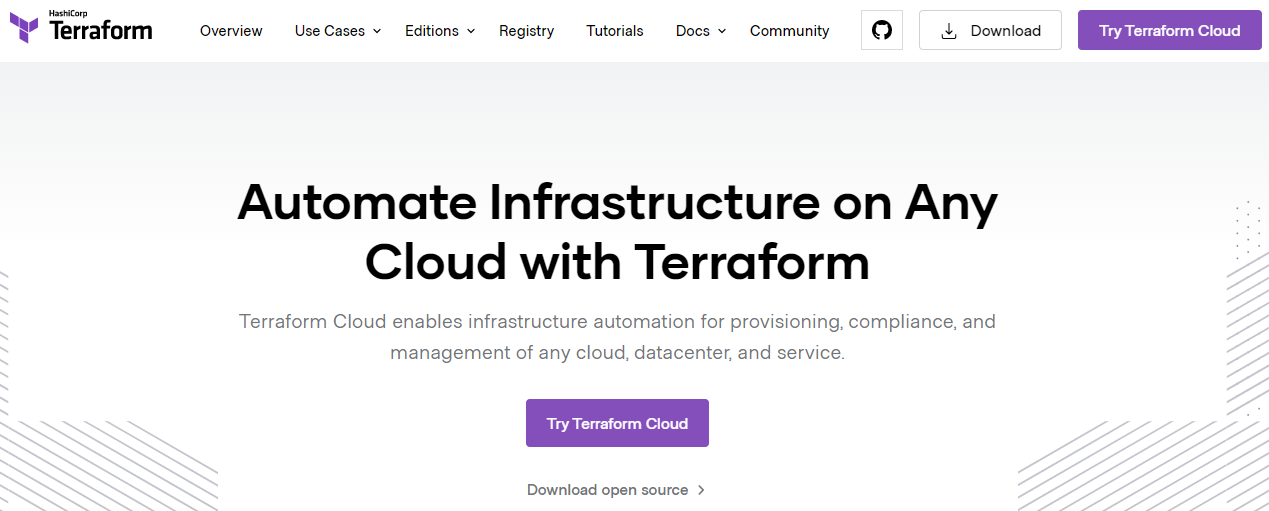
Many DevOps tools exist in the market, but Terraform stands out with its platform-agnostic language. It helps define the resources as well as the dependencies. It uses HashiCorp Configuration Language, making it easier to modify the infrastructural configurations.
Features:
- It has a state management system that tracks the current state of infrastructure resources and their dependencies.
- It helps manage changes to infrastructure configurations and switch to a previous state if necessary.
- Terraform has a robust module system that allows users to create reusable infrastructure configurations and share them with other users.
7. RackHD
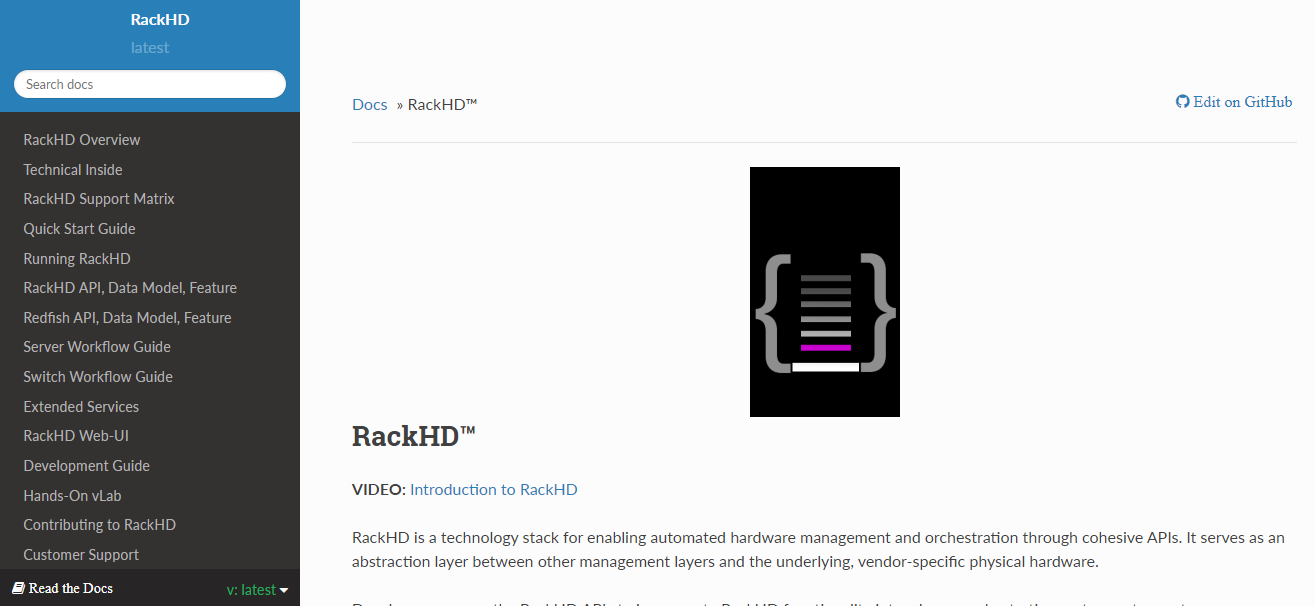
RackHD is a reliable software that helps automate the deployment, configuration, and management of physical servers and networking devices. It provides APIs and tools for hardware management, allowing organizations to automate their IT infrastructure management and reduce errors and downtime.
Features:
- It has an API layer that abstracts the underlying hardware details, making it easier to manage and automate heterogeneous hardware.
- Its workflow engine allows the users to define and execute complex workflows, such as firmware updates, network configurations, and hardware diagnostics.
- It can be integrated with Puppet and Ansible to manage software and hardware configurations at once.
8. Vagrant

Choosing one from hundreds of DevOps tools can be challenging, but Vagrant is a no-brainer. This tool allows the developers to design and manage the development environments. The developers can consistently design virtual machines.
Features:
- It supports VirtualBox, VMware, Docker, and Hyper-V and can be integrated with Ansible and other tools to automate the IT framework’s configuration and provisioning.
- It has various features for sharing and managing the development environment’s environments.
9. TeamCity

The last tool on our list is TeamCity. TeamCity is designed to help software development teams automate their build, test, and deployment processes, making releasing high-quality software more quickly and efficiently easier.
Features:
- It has various triggers that can initiate and schedule the builds.
- The best thing about this tool is that it integrates with testing frameworks like JUnit, NUnit, and Selenium, allowing users to run automated tests as part of the build process and report test results.
- It provides build logs, build stats and test results.
Six Open Source DevOps Configuration Management Tools
Below is the list of free and open source DevOps configuration tools. The inclusion of open-source tools is particularly relevant for DevOps practitioners seeking comprehensive control and flexibility in tailoring their processes.
Opting for open source tools ensures unhindered customization without restrictions imposed by developers or limitations inherent in pricing packages.
10. SaltStack (Salt)
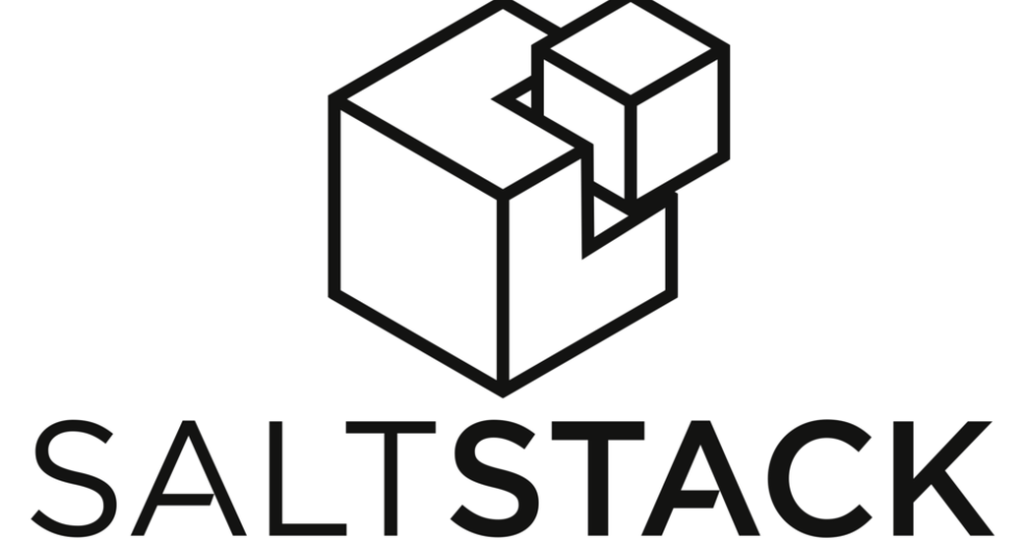
SaltStack, often referred to as Salt, is an open-source configuration management and automation tool. It is known for its speed and scalability, making it suitable for managing large-scale infrastructures. Salt uses a master-minion architecture, where the master node controls the configuration of the minion nodes.
Key Features:
- Agent-based architecture with a master server.
- Supports event-driven automation.
- Highly scalable for managing large and complex environments.
- Rich library of predefined modules for various tasks.
- YAML-based configuration files for easy setup.
11. JUJU

JUJU offers a high-level abstraction layer for defining application models, enabling users to focus on the application architecture and prerequisites. This tool also supports message queues, Microservices, and databases. It can automatically configure and connect application components.
Features:
- It has reusable charms, which are the predesigned packages for configuring and deploying the software details.
- It has an integration and automation framework, allowing users to integrate their applications with existing workflows and tools easily.
- JUJU also has an API for integrating with other tools and systems.
12. Podman

Podman is an open-source containerization tool that provides a Docker-compatible interface for managing containers without requiring a central daemon. It focuses on security and allows users to manage containers, pods, and container images effectively.
Key Features:
- Docker-compatible CLI for easy migration.
- Supports rootless containers for enhanced security.
- Ability to manage pods for orchestrating multiple containers.
- Compatibility with container registries like Docker Hub.
- Namespace and cgroup support for process isolation.
13. Nomad

HashiCorp’s Nomad is an open-source cluster manager and orchestrator designed for deploying and managing applications and services across large-scale, dynamic infrastructures. While it can work with Docker containers, it is not tied to Docker and offers flexibility in container runtime choices.
Key Features:
- Job scheduling and orchestration for applications and services.
- Multi-datacenter and multi-region support.
- Support for various task drivers, including Docker, Java, and more.
- Integration with HashiCorp’s Consul for service discovery and networking.
- Declarative configuration with HashiCorp Configuration Language (HCL).
14. Packer
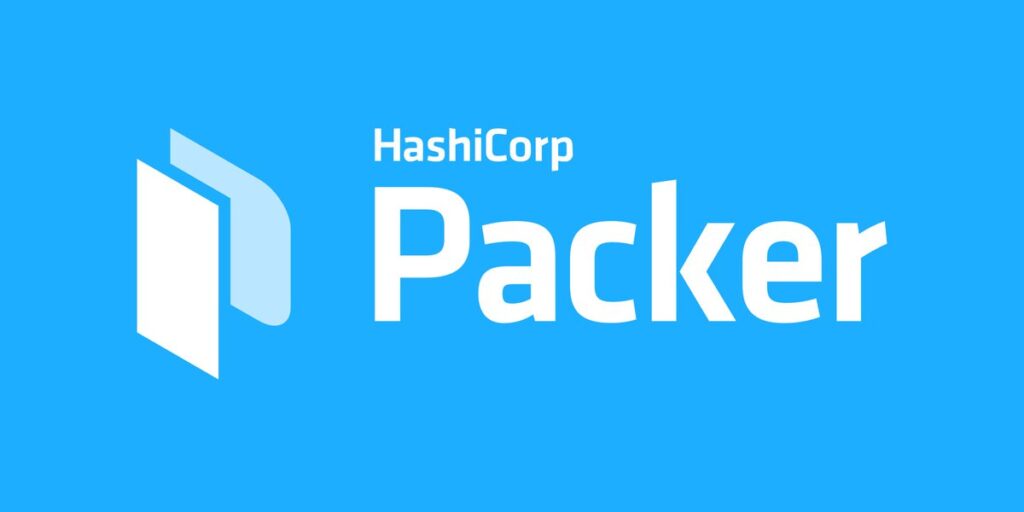
Packer is an open-source tool for creating machine images, such as virtual machines or container images, from a single configuration. It allows you to define infrastructure as code, ensuring consistency across different environments.
Key Features:
- Automates the creation of machine images.
- Supports multiple builders, including AWS, Azure, Docker, and more.
- Templated configurations using HashiCorp Configuration Language (HCL).
- Integration with various DevOps and cloud tools.
15. Delphix Continuous Data & Compliance

Delphix’s programmable data infrastructure empowers development and testing teams by swiftly provisioning relational, NoSQL, and cloud-native data, facilitating a rapid pace of cloud adoption through personalized read/write datasets and automated control.
With the ability to maintain production data on-premises while seamlessly operating non-production dev/test environments in the cloud, Delphix ensures data is delivered at a pace aligning with accelerated release schedules.
Key Features:
- Keep production data on-premises while concurrently operating non-production development and testing environments in the cloud.
- Ensure data delivery aligns with a fast-paced release schedule.
- Streamline software triage by rapidly reconstructing data states for efficient break/fix analysis.
These additional tools for DevOps configuration and management as they provide a diverse set of capabilities for containerization, orchestration, and automation in DevOps environments. The best part about these tools is that all of them are well-suited for AWS based applications.
Apart from these tools, you can also opt for DevOps consulting services to speed up your transformation and configuration process.

Optimize Your DevOps Process with Folio3 Managed Services
Our DevOps Managed Services provide end-to-end solutions for your DevOps needs. From continuous integration and delivery to monitoring and optimization, we’ve got you covered.
Expert Recommendations on Best DevOps Configuration Management Tools
Insights from top industry experts, CEOs, and founders share their top DevOps configuration management tools.
1. Utility-Focused Automation Tools

Jaden Oh – Chief Marketing Officer (CMO) at TRAFFV
“As a CMO and entrepreneur, I have worked closely with DevOps teams building streamlined development pipelines. In my experience, the best configuration management tools are those that are designed to maximize utility and automation.
Tools like Terraform, Ansible, and Chef provide an efficient solution to managing configurations, deploying applications and infrastructure, and optimizing performance.
I recently worked with a team that used Ansible to create a clean room data environment for their AI/ML applications, allowing them to safely store and process sensitive data. By automating the data environment, the team was able to reduce their time-to-deployment and increase the security of their data.”
2. Maksym Lushpenko Founder of Brokee

1. Which DevOps configuration management tool do you consider the best and why?
“I am a fan of Ansible because it’s very easy to get started and it doesn’t require any installation on systems or a centralized server (although you can have centralized management for Ansible if you want more advanced team features). Plus, it’s as powerful -if not even more so – as any other tool on the market.
2. How does this tool help in managing the configuration ofinfrastructure and applications? and What tips can you give toother?
I would use Jenkins to perform configuration management activities in a centralized way, and our teams would push code changes to Git. Then the automation pipeline would roll out those changes to a fleet of servers with Ansible. I’d give the advice to start simple. Get yourself familiar with how the tool works, learn to configure one server at a time, then, once you’re comfortable, expand to a fleet of servers. Also, you can use Vagrant to test out many things as it allows you to use virtual machines on your laptop that can mimic your on-premise infrastructure if you are as limited with server capacity.
3. Could you please share a relevant case study or project you have worked on using the recommended tool, and how it improved the overall DevOps process?
We had a big success using Ansible at a large telecom provider in the Netherlands. Our IT department of 200 people where managing servers to provide TV services. The whole infrastructure was on-premise (company-owned IT infrastructure). I was part of the DevOps team and we needed to provide training and guidance for the rest of the department on how to speed up deployments and reduce the number of manual errors.”
3. Percy Grunwald Technical Lead at Cisco Meraki

“Personally, I consider Ansible to be one of the best DevOps configuration management tools. Its simplicity and ease of use make it a great choice for managing infrastructure and applications. Ansible’s YAML-based syntax is intuitive and allows me to define the desired state of the infrastructure in a declarative way. Its ease of use, flexibility, and strong community support make it stand out from other tools.
With Ansible, I can easily manage configuration files, deploy updates to servers, and automate routine tasks. It helps me to maintain consistency across the infrastructure and streamline the deployment process, leading to faster releases and reduced downtime.
One tip I can give to others is to make use of Ansible’s roles feature, which enables you to organize your playbooks into reusable units of work. This can save time and improve the readability of your code.
In terms of a relevant case study or project, I recently worked on a project where we used Ansible to automate the deployment and configuration of a high-volume log aggregation and system monitoring tool. Before Ansible, this process was manual and error-prone, leading to frequent downtime and slow release cycles. With Ansible, we were able to reduce deployment time from hours to minutes and achieve 99.99% uptime. This improved the overall DevOps process and allowed us to focus on more important tasks such as improving the tool’s functionality and performance.”
4. Shahid Ali Khan Lead Technical Staff (DevOps) at LambdaTest

1. Which DevOpsconfiguration management tool do you consider the best and why?
“Currently we are using Ansible for our DevOps configuration. We did a lot of research on this along with lot of other tools like saltstack, however there were some advantages with Ansible that clearly made it a winner Agentless Architecture -> Where there were some other tools with this feature, Ansible was most user friendly to use in this regard. Agentless architecture also helped us reduce overhead associated with managing and maintaining agents on multiple machines, and ultimately helped us streamlining our infrastructure and making it easier to scale. Ansible uses easy YAML. Made it easy to configure and setup Large library of prebuilt modules Strong security Support for multiplatform – Which for us was very important as we provide an online test execution platform with 3000+ different environment types, all managed with Ansible.
2. How does this tool help in managing the configuration of infrastructure and applications? and What tips can you give to others?
Here at LambdaTest we are building a cloud based test orchestration and cross browser testing platform. We help users execute millions of tests everyday across 3000+ different configuration types of machines. So the scale of virtual machines running at a single point of time is massive at our end. Handling such a number of virtual machines along with making sure that our production is intact and customers are not impacted is a very critical task. Ansible helped us by streamlining management processes and helped us automate a lot of repetitive tasks around deployment and system configurations. In addition it also has great monitoring and reporting features which is a great plus.
3. Could you please share a relevant case study or project you have worked on using the recommended tool, and how it improved the overall DevOps process?
Here at LambdaTest we are working with a massive amount of virtual machines and hardware based machines to serve our customers. As we kept growing, maintaining these machines on a day to day basis like keeping settings up to date, rolling out updates across multiple machines, and keeping the configurations in sync became a challenging task. Doing all this manually or even via automation scripting for hundreds of thousands of machines running 3000+ configurations, would require hours or even days of work. All of this was difficult to scale up and induced a lot of errors in the overall system. By adding Ansible to our day to operations we were able to perform all these operations with just a click and that too in lot faster manner. We also reduced a lot of human based errors or misses across machine configurations. All of this gave us end to end observability on our infrastructure health, especially in terms of machine availability, health, security, and scale.”
5. Vaibhav Kakkar Founder at DWS & RankWatch Inc

“When it comes to configuration management (CM), there are a few tools that often get recommended. These include Puppet, Chef, and Ansible. Each has its own strengths and weaknesses, so it can be difficult to decide which one is the best for a given situation.
One of the benefits of using a tool like Puppet is that it can be used to manage both infrastructure components (like servers) and applications (like web applications). This means that it can help to improve the overall DevOps process by ensuring that all the different pieces of an application are configured correctly.
Another advantage of Puppet is that it is relatively easy to learn. This makes it suitable for beginners who want to start managing their infrastructure in a more automated way. Additionally, Puppet can be integrated with other software tools, such as Git or JIRA, which makes it even more powerful.
In terms of case studies or projects where Puppet has been used successfully, one example is the Omega Project at Citrix: this project was started in order to improve the performance of Citrix XenServer virtual machines. By using Puppet to manage the configuration of XenServer instances, they were able to achieve significant improvements in performance.
As you can see, there are many reasons why Puppet would be a good choice for someone looking for a CM tool. So if you’re wondering which option is right for you, consider consulting some experts in the field before making your decision.”
6. Surya Sanchez Automation expert Founder at DeepIdea Lab

“In response to your specific requirements, I would like to recommend Ansible as the best DevOps configuration management tool. Ansible is an open-source tool that is easy to use and has a low learning curve. It allows for the automation of infrastructure and application configuration management, making it a valuable tool for DevOps teams.
One tip I can give to others is to use Ansible’s playbook feature, which allows for the automation of complex tasks and the ability to easily replicate them across multiple servers.
In terms of a relevant case study, we recently worked with a client in the healthcare industry who was struggling with managing their infrastructure and application configurations. By implementing Ansible, we were able to automate their configuration management process, resulting in a significant reduction in errors and downtime. This ultimately improved their overall DevOps process and allowed them to focus on other important aspects of their business.
As requested, my full name is Surya Sanchez and I am the founder of our US-based IT consultancy. I have included a link to our website for your reference. Thank you for considering me as a source for your article.”
7. Ryan Gray Founder & CEO NameHero

1. Which DevOps configuration management tool do you consider the best and why?
“I believe that the best DevOps configuration management tool is Ansible. It’s easy to use yet powerful enough for complex scenarios. For example, it works with all major IT platforms like Windows and Linux and integrates quickly into existing environments; it allows us to create playbooks that define our desired state of infrastructure deployments. In addition, its open-source nature makes it extendable if necessary. Plus, Ansible works well with other automation technologies, such as Docker. Furthermore, if we consider scalability, this platform can move quickly between on-premise operations and cloud services without too much hassle or extra investment in hardware or staffing. And last but certainly not least, using Ansible requires little effort in keeping compliance standards up to date since most of them only need a few manual inputs by administrators at any given time for successful operation.
2. How does this tool help in managing the configuration of infrastructure and applications? and What tips can you give to others?
Ansible is a great way to manage the configuration of infrastructure and applications, as it automates many processes. For instance, it can be used for deploying code updates or configuring servers without requiring users to enter every single command line manually. This means deployments and configurations can happen faster and with fewer human errors. Moreover, Ansible simplifies disaster recovery processes since all necessary information regarding system health is saved in one secure, centralized place from which any other administrator could access in times of need. My top tip for those who want to use DevOps tools like Ansible is: to document everything! Also, make sure your playbooks are written down so that new team members coming on board don’t have too much trouble understanding what’s going on when they join the project or company; this would ensure smooth operation even if somebody unexpectedly quits the job or gets sick due to whatever reason that prevents them from continuing their role at hand.
3. Could you please share a relevant case study or project you have worked on using the recommended tool, and how it improved the overall DevOps process?
I recently worked on a project where our team was tasked with deploying numerous applications and services in the cloud. We decided to go with Ansible as it allowed us to quickly set up, provision, and configure servers through a single command line interface without manually intervening for every task involved. This saved us time when we had several hundred instances running simultaneously.”
8. Kevin LI, Founder of Quackr.io

1. Which DevOps configuration management tool do you consider the best and why?
“I consider Ansible to be the best DevOps configuration management tool. It is a free, open-source automation engine that helps to automate various IT tasks, including infrastructure and application configuration. Ansible emphasizes the use of simple configuration files written in YAML and uses an agentless architecture that requires no software to be installed on the remote machines. This makes it easy to deploy, configure and manage complex environments. Additionally, it has strong support for multi-tier deployments, making it well-suited for DevOps projects.
2. How does this tool help in managing the configuration of infrastructure and applications? And What tips can you give to others
Ansible helps to manage the configuration of infrastructure and applications by providing a simple, declarative language that is easy to read and understand. It also provides a library of pre-written modules for services such as Amazon Web Services, Microsoft Azure, and Google Cloud Platform. This makes it easier to configure and manage cloud-based environments. Additionally, Ansible provides idempotency, which ensures that the same configuration is applied each time, reducing the amount of manual work required.
3. Relevant case study or project using the recommended tool, and how it improved the overall DevOps process?
I recently worked on a project for a client who wanted to automate the provisioning of their cloud infrastructure using Ansible. We were able to quickly configure the cloud environment using Ansible modules, and then used the same modules to deploy the application code and configure the application’s services. The end result was a fully automated DevOps pipeline that allowed the client to quickly and reliably provision their cloud environment. To get the most out of Ansible, I recommend using the best practices outlined in the official Ansible documentation, such as using version control for all configuration files, using roles to separate configuration logic, and using Ansible-Lint to check for any potential errors. Additionally, it is important to keep Ansible up to date to ensure that all of the latest features and bug fixes are available.”
9. Harman Singh Director at Cyphere

“I believe the best DevOps configuration management tool is Ansible. It is an open source automation platform that helps teams manage the configuration of servers, applications, and services. Ansible simplifies the process of managing complex environments by providing an easy-to-use, agentless platform that automates configuration management, application deployment, cloud provisioning, and more.
Ansible helps manage the configuration of infrastructure and applications by providing an easily customizable solution. Its playbooks are written in YAML, which allows for a straightforward and human-readable scripting language. With Ansible, users can automate the deployment and configuration of applications, as well as define infrastructure-as-code. This allows teams to quickly and efficiently make changes to their environments while keeping their configurations organized and up-to-date.
I recently worked on a project where we used Ansible to manage the configuration of our servers, applications, and services. This allowed us to save time and resources as we could easily automate the deployment and configuration of our applications. It also allowed us to standardize our configurations across different environments, ensuring that all of our environments were reliably consistent. As a result, the DevOps process was greatly improved and our overall efficiency increased.”
10. Salim Benadel Founder & MD at Storm Internet

“RackHD is an automated tool for managing and orchestrating hardware that integrates with APIs. Developers can construct an interface for consumers as a single access point for managing all the hardware services using the APIs offered by RackHD. It has a sizable community channel as well as a RackHD Chinese channel for conversations in that language. To promote a community-driven process, documentation, and code are made available without any service agreements or warranties.
You may automate a wide variety of administration processes using RackHD, including the following: installation, bug creation, and feature requests. Make available the installation and updating of firmware, as well as the provisioning of server operating systems. provides direct telemetry from the hardware as well as data streams for all alerting methods.”
11. LeoYe CEO and Co-founder at Cubo

“Ansible as the best DevOps configuration management tool: Because of its open-source nature, its ease of use, its automation capabilities, and its strong integration skills, I, a professional myself, propose Ansible as the best DevOps configuration management solution. There are several reasons for this recommendation. It assists in managing infrastructure and applications by automating repetitive processes, which lowers the risk of errors and enhances system consistency. This is accomplished through the use of robotic process automation (RPA). To others, I would recommend devoting some time to understanding Ansible and beginning with a simple project.
One of the key projects that I worked on with Ansible was for a huge e-commerce platform. For this project, we automated the deployment and configuration of several servers, which not only helped the entire DevOps process but also assured that the site ran smoothly.”
12. Dave Conway Co-Founder at EcoMotionCentral

“In my experience, the best DevOps configuration management tool is Ansible. It is a simple yet powerful tool that can be used to manage complex applications and environments. It is open source, so it is free to use, and it is extremely easy to learn and use. Additionally, it is highly scalable and can be used to manage large and complex environments. The tool also has great documentation and a vibrant community of users who can provide support and guidance.
I recently worked on a DevOps project for a large enterprise client. We used Ansible to manage their entire software stack and to automate their deployment process. We were able to reduce the time it took to deploy their applications from days to minutes. We also used Ansible to manage their entire cloud infrastructure and to ensure that their applications were always up and running. The tool worked flawlessly and allowed us to quickly and easily deploy and manage their applications.
Overall, I believe Ansible is the best DevOps configuration management tool. It is easy to use, highly scalable, and can be used to manage complex applications and environments. Additionally, it is open source and free to use, and it has a great community of users who can provide support and guidance.”
13. Bennett Heyn Founder & CEO of Parker Marker

“In my experience, I have found that the best DevOps configuration management tool is Ansible. Ansible is an open-source automation platform that helps in managing the configuration of infrastructure and applications. It is easy to use and provides a simple way to define and deploy applications. Additionally, it is highly scalable and can be used to manage large-scale deployments.
I have worked on a project using Ansible to manage the configuration of a large-scale deployment for a client. This project involved automating the deployment of applications and infrastructure components across multiple servers. We used Ansible to define the configuration of the servers and to deploy the applications and infrastructure components. This allowed us to quickly and efficiently deploy the applications and infrastructure components, which improved the overall DevOps process.
In conclusion, Ansible is the best DevOps configuration management tool due to its ease of use, scalability, and ability to quickly and efficiently deploy applications and infrastructure components.”
14. Edward Mellet, Director at WikiJob

“CFEngine: When it comes to centralized management of servers, systems, users, embedded networked devices, mobile phones, and more, CFEngine is one of the more established open-source configuration management technologies. We evaluate Puppet, another well-established framework: Unlike Puppet, which is written in Ruby, CFEngine is written in C. As a lower-level language, C has a steeper learning curve than CFEngine, which is a common criticism. However, this does mean that CFEngine uses much less memory, is more efficient, and has fewer bug dependencies.”
Conclusion
Choosing a reliable configuration management tool for DevOps is a challenging process, but with a proper DevOps consultancy, you can easily achieve your goals. Further, they are important for modern app/software development and deployment. They allow the development teams to automate the IT infrastructure and ensure reliable deployment of the apps.
All the tools mentioned in this article are trusted by professional developers, so which one will you use?

